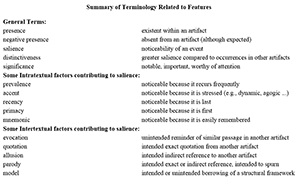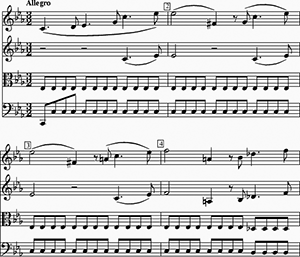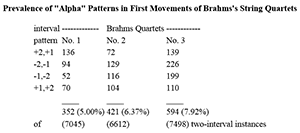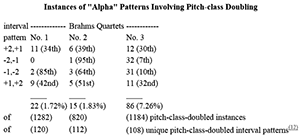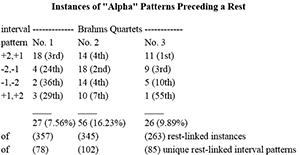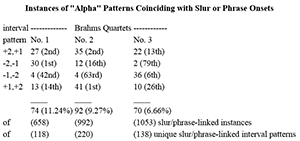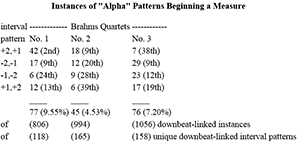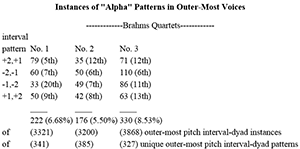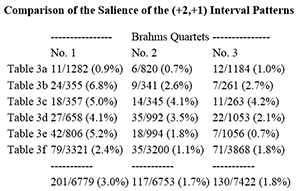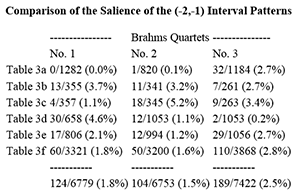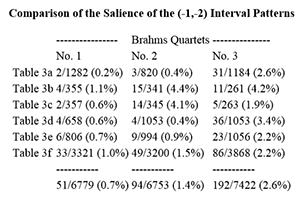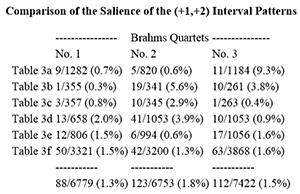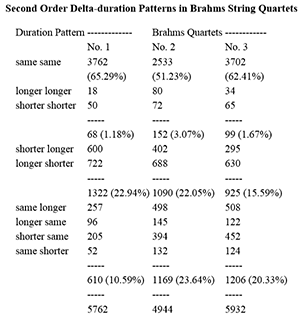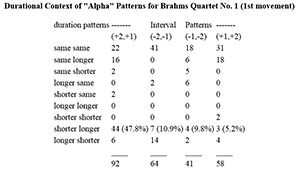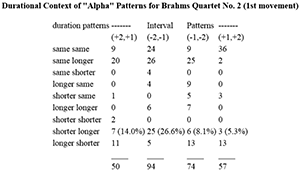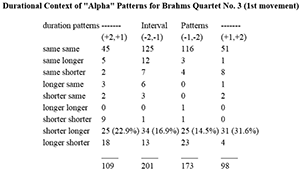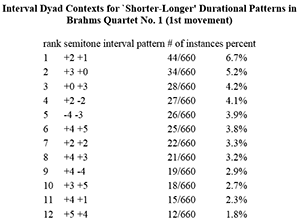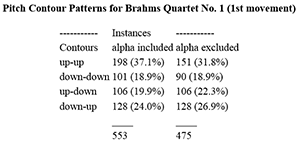What is a Musical Feature? Forte’s Analysis of Brahms’s Opus 51, No. 1, Revisited
David Huron
KEYWORDS: analysis, feature, motive, Brahms, Forte
ABSTRACT: A theory of musical features is presented. The theory emphasizes how a given work is distinguished from other works in some musical corpus. A number of general concepts are defined including presence, salience, distinctiveness, and significance. Intratextual factors such as prevalence, primacy, and recency, are distinguished from intertextual factors such as evocation, quotation, allusion, parody, and model. The theory is illustrated by evaluating the principal motive proposed by Allen Forte in his study of Brahms’s opus 51, no. 1. Forte’s “alpha” interval-class set is shown to be unable to distinguish quartet No. 1 from other quartets by Brahms. On the basis of the theory, several refinements are made to Forte’s alpha feature. Only when the prime form of the interval-class pattern is joined with a long-short-long rhythm does the resulting feature become distinctive of the work. Perceptually-pertinent properties are shown to be helpful in assembling a distinctive feature definition.
Copyright © 2001 Society for Music Theory
Introduction
[1] Imagine that you were robbed by someone and were later asked by the police to provide a description of your assailant. Suppose you began your description by noting that the robber had a nose, two eyes, a mouth, and two ears. These “facts” would undoubtedly be “true,” but the police would be rightly dismayed by your description for the simple reason that the facts fail to distinguish your assailant from a world of potential suspects.
[2] When characterizing a musical work it is important, not simply to make accurate or truthful observations about its organization; but also to identify those characteristics that set the work apart from other musical works. In this paper, I will argue that music analyses can occasionally fall prey to such empty descriptive language. Like the description of our hypothetical robber, many otherwise truthful observations simply fail to be informative.
[3] The paper is divided into two parts. Part One begins with a general theoretical discussion concerning the notion of a “feature.” In the course of this discussion a number of properties of features will be distinguished and a set of corresponding terms defined. In Part Two, the concepts developed in Part One will be illustrated by referring to Allen Forte’s discussion of motivic design in the first movement of Brahms’s string quartet, opus 51, no. 1.(1) In particular, the analysis will focus on what Forte identifies as the principal motivic feature of this work. Using the theoretical concepts related to features, several refinements will be made to Forte’s motivic description. In effect, a “nose” will be transformed into an “aquiline nose”; “two eyes” will be transformed into “close-set eyes.” To anticipate our results, this systematic analytic path will ultimately lead us to a motivic description that closely resembles a traditional diatonic motive as the principal intratextual feature of this work.
[4] At the outset, it is important to reassure readers about the goal of this essay. The paper should not be regarded as an attack on Prof. Forte. Forte’s motivic study simply provides a convenient illustration of a problem that is common in music analysis. My intention is simply to demonstrate that grievous problems of descriptive language are evident even in the work of renowned theorists—and to show that such problems are (at least in principle) avoidable.
PART ONE: WHAT IS A FEATURE?
[5] In common parlance, a “feature” is a notable or characteristic part of something; a feature is something that helps to distinguish one thing from another (or one group of things from another group of things). An architect, for example, can distinguish a Corinthian column from Doric and Ionic orders by the presence of sculpted acanthus leaves near the top of the column. We might say that sculpted leaves are a feature of the classic Corinthian column. In the analysis of artistic artifacts, features provide the essential descriptive primitives by which the unique characters of individual works may be identified, and by which the commonalities of styles, periods, and genres may be portrayed.
Properties of Features
[6] At a minimum, we might expect a proposed feature to be present in an artifact or class of artifacts. If it is claimed that X is a feature of work Y, then we would naturally expect X to be located, or evident in Y. Sometimes features may be notable by their absence, however. For example, the absence of harmonic thirds and sixths in a tonal-period work would be something of an aberration. Since, the absence of something commonplace may itself be noteworthy, we might refer to this property as negative presence. Note that negative presence presupposes the existence of a normative repertoire or established set of expectations. That is, one can’t recognize that something is missing unless one has a sense of what is normally present.
[7] In the arts, it is common to focus on the work of art as the object of analysis. This focus allows a distinction to be made between those features that arise within the context of the work itself (intratextual) and those that arise from relationships between works (intertextual). Both positive presences and negative presences may be either intertextual or intratextual. An intertextual negative presence arises when the accumulated evidence suggests that a work belongs to a certain class of works, yet fails to exhibit a property that is otherwise assumed to be essential to membership in that class or group. By contrast, an intratextual negative presence arises within a work when the work itself establishes the expectation of some event or phenomenon that nevertheless remains unrealized. Since the thwarting of an expectation may quickly become a cliché, intratextual features are constantly being transformed into intertextual norms.(2)
Descriptive Languages
[8] In describing features, an important consideration is the nature of the descriptive language used. Note that even in the case of positive presences, a proposed feature is rarely directly represented in an artistic artifact. For example, the pitches of a score do not directly encode the melodic intervals. The concept of “melodic interval” relies on the assumption of an underlying “voice” or “part” and deciphering voicing sometimes entails remarkably sophisticated interpretations. On what basis, then, can one defend the assumption of voice? Those theorists who have contemplated such matters typically rely on one of two appeals. One might appeal to notational conventions such as the use of separate staves or differentiation via stem direction. A more common appeal is to the perceptual experiences that affirm the subjective phenomenon of “musical line” and hence of “melodic interval.”(3) We often assume that the notational conventions of stem directions and independent staves are straightforward reflections of a common psychological experience. That is, theorists rightly consider melodic intervals to be implied by individual successive pitches, and rightly assume that such intervals may be readily derived in most circumstances.
[9] In fact, few features can be identified in the “raw data” of an artifact. Like melodic intervals, most features are deciphered, interpreted, or derived from the object of analysis. Of course, even the “raw data” are interpreted. What makes the data seem ontologically “raw” is that the interpretations are comparatively stable and uncontentious. We can continue to use such terms as “raw data” as a linguistic convenience, although the term should be understood as a short-hand for interpretations that are less contentious—and the term should never be seen as a foundation that is immune to further conceptual analysis or challenge.
[10] Of course, derived presences may be much more indirect than is the case for melodic intervals. Derived presences may include such concepts as deceptive cadences, prolongations, syncopations, suspensions, ritornellos, and other phenomena. Often, these derived concepts are more notable and compelling features than directly notated pitches or durations.
[11] Note that there are an infinite number of possible derived presences, and not all such derivatives can have the same analytic status. For example, one might rigorously define the property fuddle to be the semitone pitch distance between the second-last notes occurring in odd numbered measures whose stem directions extend upward. Implicit in any descriptive language is the idea that the descriptive terms (such as “melodic interval”) are not reified concepts, and that, unlike the concept of fuddle, they represent some organizing principle that has influenced either the construction of the work, or its reception, or both. In the case of conventional tonal theory, the notion of a diatonic step is an example of such a derivative concept. In the case of set theory, the notion of an interval-class is an example of such a concept.
[12] In discussing above how theorists might defend the traditional voice assumption underlying the concept of the melodic interval, two different forms of justification were cited. One was based on subjective perceptual experience, and the other was based on notational practice. It is important to understand that these are just two of innumerable forms of appeals. One need not refer either to perception or to the notation in order to justify a useful descriptive concept. Consider, by way of illustration, the notion of something being “idiomatic.” In works written for trumpet, it has been observed that difficult finger/valve combinations are systematically less common in works written by trumpet virtuosi than in trumpet works written by non-virtuosi.(4) In most circumstances, it is only the experienced trumpet player who is able to apprehend the specific properties that distinguish an idiomatic arrangement from an unidiomatic arrangement. That is, a trumpet player may experience a passage according to such categories as “easy to finger” or “difficult to finger.” Moreover, these conceptual and descriptive categories can be defended, even if listeners are unable to perceive them, even if non-trumpet performers fail to experience them, and even if theorists are oblivious to their existence.
[13] Descriptive languages are often unique to particular communities. Usually, the language is largely given a priori, but there are always opportunities to change or expand the descriptive conceptual vocabulary. A composer might choose to create a work whose organization is intimately linked to the fuddle concept. If this were the case, this aspect of the music’s organization would have salience only for readers of this article—and even then, only for readers with access to the notated score. This simply illustrates that useful descriptive concepts can spring into existence within a given community or culture.
[14] When we describe features, we are at liberty to choose the descriptive language, although the language must contain concepts whose assumptions have some degree of support. In describing a robber to the police, an optician might focus on the robber’s brand of eyeglasses, a fashion designer might focus on features of the robber’s clothing, and a dialect expert might focus on the robber’s manner of speech. Within each of these descriptive domains, however, it is still possible to give either fruitful or empty descriptions. The optician’s recognition of a common brand of sunglasses, the fashion designer’s notice of poor color-coordination, and the dialect expert’s animated description of the robber’s impolite vocabulary may be of little use in distinguishing our robber from anyone else.
[15] In identifying a feature, we must always be cognizant of the question “feature of what?” Features may be characteristic of a work, of a movement, of a composer, of a style, of tonal music in general, and so forth. What constitutes a feature depends on the scope of our gaze. For example, a non-Western listener may deem the sound of the pianoforte to be a significant feature of Western music—without distinguishing any further divisions. To the music analyst, the features of principal interest have been those that characterize individual works, or sections thereof. At the supra-opus level, features of interest may include stylistic features, the three basic lines of Schenkerian analysis, and so on.
Salience
[16] The mere presence of some element or property does not necessarily make it a good feature. A good feature must in some ways draw attention to itself. It must be notable, or what might be dubbed salient. Of course there are innumerable ways by which something may draw attention—some of which we will discuss later. One of the most venerable properties is the simple prevalence of an event; that is, how frequently a pattern recurs.
[17] Apart from such intratextual factors, there are also intertextual factors that can contribute to salience. A single statement of “B–A–C–H” or the opening notes of Dies Irae can be sufficient to establish the notability of the event. Intertextual factors may be either intentional or unintentional on the part of the artist. Intentional factors may include quotation, allusion, parody, and model—concepts that have received some lucid theoretical attention.(5) To these may be added the concept of evocation where a passage unintentionally reminds the listener of a similar passage in another work. (Since evocation is defined as unintentional, the clearest examples occur where a musical passage reminds us of a similar passage in a work created much later by another composer.)
[18] To summarize, we may define salience as a heightened attention that can arise due to either intratextual factors (such as phenomenal accent) or intertextual factors (such as quotation).
Evaluation of Features
[19] All scholarly disciplines are founded on some type of descriptive enterprise. Features provide the essential building-blocks for such descriptions. Each discipline establishes its own criteria for good description; however, some evaluative criteria are nearly universal and possibly tautological. Perhaps the most important property of a description is the degree to which it distinguishes the objects of our attention from other (possibly like) objects. If the goal of an analytic description is to convey what is unique or distinctive of a given object or class of objects, then good features must embody or define some of that distinctiveness.
[20] Another important property of feature descriptions is the economy of the means of expression. When asked for directions by a passing motorist, the success of our description depends not only on the distinctiveness of the landmarks we mention, but also—since human memory is fallible—on the brevity of our description. Of course, in giving directions to our motorist, we might ask if they are already familiar with certain landmarks. In inquiring about their existing knowledge, we are, in effect, determining whether intertextual references will have any value in enhancing the description. Whether or not our motorist has knowledge of the pertinent geography, a good description will identify a succinct set of distinctive features.(6)
[21] In the absence of distinctiveness, many otherwise truthful characterizations are without merit due to the excessive breadth of the description. In concrete terms, we may define distinctiveness as the property of “relative salience”—that is, where a feature is more characteristic of the artifact being described compared with other artifacts or phenomena. Note that the property of distinctiveness is necessarily comparative.
[22] Once again, what constitutes a distinctive feature depends on the scope of our gaze. A “nose” is a feature of faces in general, but the presence of a nose cannot be a feature of a particular face. It is the “stubby nose” or the “pixie nose” that may be a feature of some given face—but only because of the implied comparison with other noses.
[23] All of the foregoing attributes or properties of a feature are attempts to approach the central issue related to a feature: its importance, eminence, or significance. By their very nature, the concepts of importance and significance are open-ended. A single, apparently trivial detail may be the source of a striking story. Significance is always contextual, and there is no telling the historical, social, personal, formal or other domains that establish the context for some event—however apparently minor or inconsequential. This means that it is impossible, in principle, to produce an exhaustive inventory of the significant features of some work.
Table 1. Summary of Terminology Related to Features
(click to enlarge)
Example 1. Brahms, String Quartet Op. 51, No. 1, mvt.1, mm. 1–6
(click to enlarge)
Example 2. Some Sample Sets from Forte’s Motivic Analysis of Brahms Op. 51, No. 1, mvt. 1
(click to enlarge and see the rest)
[24] Although we cannot describe all the potentially significant features of a work, or even the most significant features of a work, this does not preclude the possibility of identifying some features that are significant. My claim here is that salient distinctive features will always bear some degree of significance in a work—even though other features may exist that can claim to be of greater significance.
[25] By way of summary, the feature-related properties we have discussed are reproduced in Table 1. In general, a good feature may be defined as a succinct description that is salient, distinctive, and significant. That is, a good feature is something that attracts our attention in some way, that distinguishes an object or class of objects from other like objects, and that is worthy of interest.
PART TWO: FEATURES IN BRAHMS’S OPUS 51, NO. 1
[26] The conceptual framework outlined in Part One may be better understood through an illustrative example. Example 1 shows the opening measures of the first movement of Brahms’s opus 51, no. 1. The opening statement in the first violin part constitutes what would normally, and informally, be dubbed the principal theme of this movement—a theme that Hanslick characterized as “magnificently passionate.”(7) Example 2 shows a number of interval-related groups that are identified in Forte’s analysis as playing a central role in this movement.(8) The most important of these sets is the interval sequence (+2,+1) which, along with its inversion (-2,-1), retrograde (+1,+2), and retrograde inversion (-1,-2), Forte dubs the “alpha” group of motives. In order to distinguish the interval patterns from the interval-class patterns we will use the unsigned designation (2,1) to refer to the interval-class pattern that embodies all four of these individual interval patterns.
[27] There is no question that the alpha pattern is present in opus 51, no. 1. The pattern occurs in the opening three notes of the first violin and appears numerous times throughout the movement. According to our analytic taxonomy, we need to consider the degree to which occurrences of this pattern are salient and distinctive.
[28] Of the various factors contributing to salience, consider first the simple property of prevalence. Out of 7,045 interval-class melodic dyads found in this movement, the alpha pattern is the most common interval-class pattern, occurring 352 times. (The prime form alone occurs 136 times making it the 13th most common two-interval pattern.)(9)
[29] However, since scale-like movements of tones and semitones are ubiquitous in tonal music, we might well expect the alpha pattern to be common in most musical works. Returning to our police station analogy, suppose that we remain unconvinced by the police officer’s protestations that saying our assailant “has a nose” is utterly vacuous. The officer might pull out a college yearbook and ask us to count the number of photographs where a person is without a nose. Having counted a large number of people, each with a nose, we might be more convinced that our description does indeed fail to be distinctive. Such a statistical demonstration might seem crude or unwarranted, but it serves the important purpose of establishing the shortcomings of our description.
[30] In order to determine whether the alpha pattern is distinctive of the first movement of opus 51, no. 1, we need to compare this movement with other musical works. But what other works would provide an appropriate comparison? If we compared Brahms’s opus 51 to (say) a Brazilian samba,(10) then the origins of any observed differences between the two pieces would be difficult to interpret. Perhaps the differences would arise due to different historical periods, or different nationalities of the composers, or different instrumentation, or different styles. In other words, the observed differences may be manifestations of different classes of compositions (such as genres) rather than differences in the works themselves.
[31] In order to minimize these interpretive problems it is preferable to select comparison works that are as similar as possible to the work we are attempting to describe. A good sample of music for such a comparison is all of Brahms’s remaining string quartet movements. Brahms claimed to have written over 20 string quartets in his youth—works which he later destroyed. Of his mature string quartets, Brahms published three: opus 51, no. 1; opus 51, no. 2; and opus 67. These works were written over a period of about a decade. By choosing this repertoire, we can be confident in dismissing claims that any differences we may observe are due to different composers, nationalities, genres, styles, instrumentation, etc. That is, any observable differences are more likely attributable to the different characters of the works. Of course the string quartet movements are not exactly “matched”—there remain differences. The various movements exhibit different tempi, forms, and moods. Rather than comparing the first movement of Quartet No. 1 with the other movements of the same work, in some ways, a better comparison might be to compare the first movements from all three quartets (No. 1: Allegro, 3/2 meter; No. 2: Allegro non troppo, 2/2 meter; and No. 3: Vivace, 6/8 meter). The different meters and the different keys mean that we cannot dismiss the possibility that any observed differences can be attributed to these factors.
Table 2. Prevalence of “Alpha” Patterns in First Movements of Brahms’s String Quartets
(click to enlarge)
[32] Table 2 tabulates the number of occurrences of each of the alpha patterns for each of the first movements of Brahms’s three string quartets. Separate results are shown for all four set variants of Forte’s interval-class motive.
[33] The results of Table 2 show that the alpha interval-class pattern is prevalent in all three quartet movements—not just in the first movement of quartet No. 1. In fact, the alpha interval-class pattern is proportionally more common in each of the other string quartet movements than it is in quartet No. 1. This implies (but does not prove) that the alpha interval-class is a musical commonplace—at least in the case of Brahms, but probably for tonal music in general. In summary, we can say that the alpha interval-class pattern is present and prevalent in quartet No. 1, but, on the basis of this single salience factor, we cannot say that alpha is distinctive of quartet No. 1.
[34] As we noted earlier, a good feature must draw attention to itself in some way. Apart from simple repetition (prevalence), there are innumerable other ways to draw attention. If we trust Forte’s intuition, we must conclude that more than mere prevalence contributed to Forte’s selection of the alpha motive. We need to look for other possible salience-enhancing properties. One place to begin is by noting that Forte selected the initial three notes of the work. In memory and learning tasks, psychologists have established that the first visual or auditory items in a sequence are more salient than other items—a phenomenon dubbed primacy. (Similarly, people are better at recalling and learning items toward the end of a sequence—a phenomenon known as recency.)
[35] We might also note that Forte chose the upper-most voice, rather than, say, the initial notes in the viola part. We can only guess as to the source of Forte’s intuition, but it is suggestive that this choice also accords with experimental research showing that listeners find outer voices, especially the upper-most voice, more perceptually salient.(11) While we are considering these salience-enhancing treatments, let’s consider some other common ones. On the most superficial level, salience can be enhanced by increasing the amount of acoustical energy (e.g., loudness and/or duration) that attends some event. All types of foreground accent (dynamic, agogic, melodic, etc.) can contribute to salience.
[36] Perhaps it is the case that alpha tends to occur in foreground or melody parts rather than in accompaniment contexts. Motivic statements might tend to be presented via unison or octave doublings, or appear in outer-voice parts. Various forms of accent may be applied; statements may coincide with metrically strong positions. The feature might be isolated from preceding and ensuing material; it might tend to appear at the beginning and ending of the work, or at the beginnings and ends of phrases.
[37] Tables 3a-f show the results of six exploratory analyses that attempt to determine the extent to which Forte’s alpha patterns are linked with various contextual treatments that may be expected to enhance salience. Table 3a shows the number of instances of the alpha patterns that involve pitch-class doublings (such as unison or octave statements). Table 3b shows the number of instances of the alpha patterns that follow a rest (implying perceptual primacy). Table 3c shows the number of instances of the alpha patterns that precede a rest (implying perceptual recency). Table 3d shows the number of instances of the alpha patterns that coincide with the beginning of a phrase or slur mark (also implying primacy). Table 3e shows the number of instances of the alpha patterns that begin on the strongest metric position (down-beat) in a measure. Table 3f shows the number of instances of the alpha patterns that occur in outer voices (’cello and first violin). In each case, the results for opus 51, no. 1, are contrasted with similar tallies for the first movements of Brahms’s other two string quartets.
|
Table 3a. Instances of “Alpha” Patterns Involving Pitch-class Doubling (click to enlarge) |
Table 3b. Instances of “Alpha” Patterns Following a Rest (click to enlarge) | |
|
Table 3c. Instances of “Alpha” Patterns Preceding a Rest (click to enlarge) |
Table 3d. Instances of “Alpha” Patterns Coinciding with Slur or Phrase Onsets (click to enlarge) | |
|
Table 3e. Instances of “Alpha” Patterns Beginning a Measure (click to enlarge) |
Table 3f. Instances of “Alpha” Patterns in Outer-Most Voices (click to enlarge) |
[38] Each table entry identifies the number of instances found, followed (in parentheses) by the rank position of that pattern in a list of all patterns in the movement—ordered by frequency of occurrence. Summary statistics for each of the three quartet movements are provided at the bottom of each table. Specifically, the total number of alpha-related patterns are tabulated, followed (in parentheses) by the percent occurrence. The total numbers of pertinent measures are also identified followed by measures of the total number of unique patterns conforming to the defined context.
[39] Consider first the summary statistics in each table showing the totals for all four interval patterns. In particular, compare the percentage occurrences for all three quartet movements. Tables 3a, 3b, 3c and 3f do not show any comparative coincidence between occurrences of alpha and pitch-class doubling, adjacent rest boundaries, or outer-voice positions. For example, Table 3a shows that only 1.72% of the alpha interval-class occurrences involved pitch-class doublings, whereas quartets No. 2 and No. 3 exhibited 1.83% and 7.26% respectively. However, Tables 3d and 3e appear to show a heightened occurrence of the alpha interval-class motive coinciding with slur or phrase onsets and beginning in down-beat metric positions—compared to the other two quartets.
[40] The results shown in Tables 3a-f are more telling if we focus separately on the four individual interval patterns subsumed by Forte’s alpha interval-class pattern, Tables 4a-d recast the data in Tables 3a-f comparing the results for each of the string quartet movements for each of the four interval patterns: (a) the prime interval-pattern (+2,+1), (b) the inversion (-2,-1), (c) the retrograde (-1,-2), and (d) the retrograde inversion (+1,+2). Only the prime form (+2,+1) in Table 4a shows a significant increased presence compared with the comparison movements.(13) With the exception of the pitch-class doubling context, the (+2,+1) interval-pattern is linked with each of the examined salience-enhancing contexts much more often than for the other quartets. That is, the (+2,+1) interval pattern is more likely to be preceded or followed by a rest, is more apt to coincide with the beginning of a slur or phrase mark, is more apt to begin a measure, and is more apt to appear in an outer voice.
|
Table 4a. Comparison of the Salience of the (+2,+1) Interval Patterns (click to enlarge) |
Table 4b. Comparison of the Salience of the (-2,-1) Interval Patterns (click to enlarge) | |
|
Table 4c. Comparison of the Salience of the (-1,-2) Interval Patterns (click to enlarge) |
Table 4d. Comparison of the Salience of the (+1,+2) Interval Patterns (click to enlarge) |
[41] Tables 4a-d suggest that it is not the alpha interval-class pattern that is distinctive of the first movement of Brahms’s opus 51, no. 1; rather the results suggest that it is the interval-specific form (+2,+1) that is distinctive. This is not to suggest that motivic inversions (for example) don’t appear in the movement. (Salient inverted statements clearly appear in measures 92–105.) It is only to say that the inversion is a rare variation of a more basic feature. It is appropriate then that Forte identifies the interval-specific pattern (+2,+1) as the prime form of the interval-class set—and uses this term in preference to the proper normal form (1,2). However, the retrograde, inversion, and retrograde inversion forms lack distinctiveness in this movement.
[42] If we wish to improve upon Forte’s alpha feature, we need to consider how the feature description can be modified or extended such that it will truly become clearly distinctive rather than merely prevalent. There are a number of candidate ideas for modifying the feature description. One of the most important candidates is to consider the relationship between pitch and duration. For example, the three notes of Forte’s alpha motive seem to be linked to a long-short-long rhythm. This suggests that we re-analyze the work with regard to patterns consisting of both interval dyad and relative duration. We might begin by first analyzing the long/short duration patterns in the three first movements in order to see if the long-short-long pattern is present, prevalent, and distinctive of opus 51, no. 1. All of the rhythmic-dyad patterns are shown in Table 5.
[43] In Table 5, the absolute duration of the notes has been of no concern; rather, a duration is deemed to be long or short depending upon the length of the preceding note. Thus the patterns “half-quarter-whole” and “half-eighth-quarter” would both be deemed long-short-long rhythms despite the fact that the quarter-duration is deemed “short” in the first pattern and “long” in the second pattern. Of course, this is only one of many possible approaches to characterizing rhythmic patterns, but we need to start somewhere.
[44] Table 5 indeed appears to suggest that the long-short-long pattern (i.e., “shorter-longer”) is more prevalent in the first movement of string quartet No. 1 than in the first movements of Brahms’s two other quartets. The pattern appears 600 times out of 5,762 contiguous 3-note instances in quartet No. 1 (i.e., 10.4% of all instances). The corresponding percentages for quartets Nos. 2 and 3 are 8.1% and 5.0%, respectively. We now need to consider possible relationships between this potential rhythmic feature and the alpha interval pattern.
[45] Tables 6a-c show the durational contexts of the alpha interval patterns for each of the first movements of the three Brahms string quartets. Some patterns (such as longer-longer and shorter-shorter) are notably rare. The important question is whether the alpha patterns in quartet No. 1 are more strongly linked to the shorter-longer (i.e. long-short-long) rhythmic contour. The answer is a resounding yes. But once again, the answer must be qualified to say that only the interval-specific pattern (+2,+1) is strongly linked to the shorter-longer durational pattern. The remaining interval-specific patterns display no more rhythmic linkage than is found in the other quartets.
|
Table 6a. Durational Context of “Alpha” Patterns for Brahms Quartet No. 1 (1st movement) (click to enlarge) |
Table 6b. Durational Context of “Alpha” Patterns for Brahms Quartet No. 2 (1st movement) (click to enlarge) | |
|
Table 6c. Durational Context of “Alpha” Patterns for Brahms Quartet No. 3 (1st movement) (click to enlarge) |
[46] An association or link between two parameters may be either unidirecitonal or bi-directional. For example, if we find that people with X-colored hair tend to have Y-colored eyes, it does not necessarily follow that people with Y-colored eyes tend to have X-colored hair. When two characteristics are reciprocally linked they form a bi-direction association. Bi-directional associations are especially noteworthy since they imply a common source or origin for both characteristics or parameters. The preceding tables (6a-c) established only that the (+2,+1) interval pattern has a strong tendency to occur in a long-short-long (shorter-longer) durational context. We should also determine whether shorter-longer durational patterns tend to coincide with the (+2,+1) interval context.
Table 7. Interval Dyad Contexts for ‘Shorter-Longer’ Durational Patterns in Brahms Quartet No. 1 (1st movement)
(click to enlarge)
Table 8. Pitch Contour Patterns for Brahms Quartet No. 1 (1st movement)
(click to enlarge)
[47] Table 7 shows the dozen most prevalent interval patterns exhibiting the shorter-longer durations in the first movement of quartet No. 1. As can be seen, the interval-specific (+2,+1) pattern is ranked first. The other set variants for alpha are not shown in Table 7 due to their especially low rankings—27th (-2,-1), 42nd (-1,-2), and 58th (+1,+2). In summary, Tables 6a and 7 show that the bond between the interval pattern (+2,+1) and the long-short-long rhythm is both strong and bi-directional. This linkage suggests that the interval and rhythm attributes share a common origin and are inextricable components of a single pattern. This finding suggests that it would be inappropriate to define the interval feature independent of its rhythmic properties. By contrast, none of the other set variants shows any such rhythmic linkage. For example, a separate analysis of the retrograde forms of alpha showed no correlation with retrograde forms of the rhythm.
[48] Further inspection of Table 7 reveals that the dozen or so most prevalent patterns show a marked predominance for ascending intervals. This bias toward ascending pitch sequences is confirmed in Table 8. Table 8 tabulates the predominance of all up-up, up-down, down-up, and down-down pitch contours in opus 51, no. 1. Of 553 interval dyads (pitch triads), nearly 40 percent are solely upward in their contours—twice as many occurrences as the down-down contour. This suggests that the specific interval sizes may be less important in our feature definition than we might think. The right-most column of Table 8 shows the number of occurrences of the various contours—where all of the alpha interval-class occurrences have been excluded. As can be seen, the up-up pattern continues to predominate. In other words, the up-up pattern remains prevalent in this movement independent of the alpha interval patterns.
[49] Returning to Table 7, we can see that the second- and third-ranked patterns outline the minor third interval—an interval that Forte also highlights in his analysis. Forte doesn’t explicitly comment on the relationship between the ascending minor third and the omission of the second note of the alpha pattern. The foregoing analysis allows us to be more explicit about their relationship. When viewed in its rhythmic-metric context, the elimination of the second pitch is hardly enigmatic. Recall that Table 3e established that the alpha pattern is more likely to begin on a strong metric position compared with Brahms’s other quartets. In addition, we have seen that the alpha patterns are associated with a long-short-long rhythm. This implies that the “middle” note of (+2,+1) has been treated as a dispensable “unaccented passing tone”—the omission of which leads quite naturally to a rising minor third.
[50] The sixth- and eighth-ranked patterns in Table 7 show what can only be interpreted as upward rising major and minor triads, whereas the seventh-ranked pattern corresponds to clear statements of the upward rising motive in the major mode (i.e., measures 232 to 260). At the time of Forte’s writing, the vocabulary of set theory was unable to accommodate diatonic intervals, and so the (+2,+2) interval pattern was defined as a separate motive (Forte’s epsilon motive, see Example 2).
[51] With regard to diatonic intervals, a further analysis found that all of the instances of the prime form of alpha occurring in the first movement of quartet No. 1 are spelled as an ascending major second followed by an ascending minor second. By contrast, nearly ten percent of the alpha retrograde instances are spelled enharmonically as diminished thirds followed by minor seconds.
A Revised Feature Description
Example 3. Schematic Representation of the Principal Motive in Brahms Op. 51, No. 1, mvt. 1 as Developed Using a Comparative Analysis Method
(click to enlarge)
[52] In light of the above analyses, we can now summarize the state of our alternative motivic description of the principal foreground feature in the first movement of Brahms’s opus 51, no. 1. The feature consists of pitches in an upward-rising sequence, linked to a long-short-long rhythm, generally starting a phrase or slur, often following a rest, beginning in a strong metric position, and most likely to occur in an outer voice. (See Example 3.)
[53] The feature bears more than a superficial resemblance to the opening statement in the first violin. In traditional tonal theory, this feature would have been informally labeled “the principal motive.” The above comparative analysis has merely formalized the evidence in support of this informal intuition.
Some Caveats
[54] It is important not to draw the wrong conclusion from the foregoing analysis. The analytic results, coupled with Forte’s penchant for using the language of interval-class sets, is apt to remind readers of three old criticisms of set theory:
- Set theory fails to account for rhythmic aspects of the music.
- Set theory specifies intervallic sizes that are inappropriately fixed and overlooks the essentially diatonic contexts of the intervals. And
- Set theory implies an equivalent or enhanced status for the retrograde, inversion, and retrograde inversion forms of the feature that are often not borne out by the work itself.
According to the view presented in this paper however, the above criticisms are merely artifacts of a more fundamental problem. The nub of the problem with the alpha pattern is that it fails to define a feature that will distinguish the first movement of quartet No. 1 from the first movements of Brahms’s other two string quartets. That is, the alpha pattern is akin to describing a robber as having a nose and two eyes.(14)(15)
[55] Although Forte’s study of Brahms’s opus 51, no. 1, is not intended to be a set-theoretic analysis, the above three criticisms are indeed warranted. But they are not warranted because rhythm is inherently important, diatonic intervals are privileged, or set theory exhibits a bias toward certain set variants. There is no telling how any given work may distinguish itself: rhythm may or may not be important, diatonic intervals may or may not be important, and set variants may or may not be important. In our analysis, these properties became important simply because they help to define a feature description that distinguishes the object under consideration from other similar objects. That is, the process of contrasting the work in question with similar works allowed us to both refine and discard elements of our descriptive language.
Review of Analytic Assumptions
[56] In presenting the above comparative analysis, there are a number of caveats
and disclaimers that must be made explicit. First, it is important to recognize
that the above analysis dealt only with intratextual elements and did not consider
possible intertextual features to opus 51, no. 1. It is always possible that intertextual
properties overshadow the intratextual elements. As noted earlier, a single statement
of, say, “B–A–C–H” may prove to be of great significance, even though such a statement
may not be prevalent. Forte proposes a plausible (and fascinating) intertextual
property of this movement when he links the C minor/
[57] Second, only a handful of salience-enhancing properties were explored in the foregoing analysis. Specifically, we examined prevalence, metric position, relative duration, voice position, primacy, and recency-linked properties. In the specific case of metric and primacy properties, there are alternative ways of measuring such properties—other than those used in this paper. Other accent types (such as melodic accent), and mnemonic properties were not explored in the above analysis. In addition, other ways of characterizing features—such as scale-degree, diatonic interval (rather than semitone intervals), or relative interval size (e.g., step/leap)—were not explored. Rather than investigating long/short durational relations, a better rhythmic feature might arise from characterizing the precise durational proportions (e.g., the 3:1 ratio of the dotted rhythm). Any of these alternative approaches might lead to a better feature description than the one exemplified in Example 3.
[58] Third, the above analysis was restricted to foreground features only. In principle, however, the same comparative methodology can be used to evaluate claims of background features. In the case of Schenkerian analysis, this approach must await some computable implementation—if this is possible.
[59] Fourth, the above claims are limited by the comparison group of works. The failure of the alpha pattern to distinguish Quartet No. 1 from Brahms’s other string quartets does not mean it is not a distinctive feature of some larger group of objects. For example, the original alpha pattern might distinguish Brahms’s string quartets from works by other composers, or other works by Brahms. Or it may be that the alpha pattern is characteristic of Brahms in general, or of Western tonal music compared to other types of music.
[60] Once again it bears emphasizing that the motivic feature shown in Example 3 is not claimed to be the “best” intratextual feature in opus 51, no. 1. In principle, it is impossible to determine the best feature, since there may always be some analytic perspective that provides a more penetrating characterization. My claim is merely that our refined feature is better than Forte’s original alpha motive.
Conclusion
[61] The identification of features is one of the essential tasks of any descriptive enterprise. Purported features can be characterized according to their presence, salience, distinctiveness, and significance. In the first instance, what constitutes a feature depends on the scope of our gaze. A feature might pertain to a particular musical passage, a movement, work, composer, period, genre, style or culture. Features may be salient because of intratextual or intertextual treatments—including prevalence, primacy, recency, evocation, quotation, allusion, parody, and model.
[62] When making observations about music, the analyst is free to choose or construct any descriptive language. However, the value of the resulting description can be evaluated only by inviting the possibility of failure. At a minimum, one needs to discern whether the description offered succeeds in distinguishing the object of interest from other similar objects. It is surprisingly easy to inadvertently describe features that may be characteristic of music in general while wrongly supposing that one is describing features of a particular work. Similarly, one might wrongly assume that descriptions of a single work pertain to an entire class of works. In this paper we have seen that otherwise truthful musical descriptions can fail to be informative because the scope of applicability has not be probed.
[63] This paper has presented an analytic method for refining and evaluating feature descriptions. The method is inherently comparative—that is, it clarifies features by placing a work in the context of a musical corpus or comparison group. The method highlights what makes one work different from another.
[64] The method allows different musical parameters to be integrated within a unified feature description. For example, the method allows the analyst to resolve whether or not particular articulation marks are integral components of a motive.
[65] In applying the method to Brahms’s opus 51, no. 1, the above partial re-analysis leads to a number of conclusions:
[66] First, it was found that although Forte’s alpha interval-class pattern is prevalent (occurs frequently) in opus 51, no. 1, comparison with other string quartet movements by Brahms indicated that the pattern is not distinctive. Distinctiveness arose only when this pattern was linked to contexts deemed a priori to likely increase their salience. This result has a number of repercussions. It suggests that the concept of salience is not a mere fiction. It also suggests that our operationally-defined estimates of salience (such as phrase onset or outer-voice position) can be useful indices of salience. In our analysis, salience was measured in terms of phrase-related primacy and recency, rest-induced grouping, unison doubling, outer-voice position, and metric position. All of these factors have been shown experimentally to enhance the perceptibility of musical events. That is, at least some forms of salience arise from known perceptual phenomena. In short, our analysis provides additional evidence that perceptual factors can be important in musical analysis.
[67] Second, we showed that it is not the alpha interval-class pattern that is the principal feature of this movement, but a particular form of the pattern. Although the concept of interval-class identity may be important in certain kinds of music, there is little indication in this movement by Brahms that interval-class patterns play any significant role.
[68] Third, we showed that the pitch-interval feature was inextricably linked to a particular rhythmic context—namely, long-short-long. Specifically, it was demonstrated that this link is bi-directional: the pitch contour is most commonly associated with the rhythm, and instances of the rhythm are most commonly associated with the pitch contour. In extending set theory to tonal works, theorists ought to develop methods for characterizing pitch-rhythm interdependencies.
[69] Finally, it should be noted that the concept of “distinctiveness” is simply an introduction to music analysis of one of the most important concepts in contemporary scientific method—namely the idea of the “disproof of the null hypothesis.” The basic idea is that whenever an observation is made, scholars should endeavor to adjudicate its pertinence by asking the question “How likely would it be that this observation might arise merely by chance?”(16) In experimental methodology, it is the so-called “control group” that plays a critical role in establishing the likelihood of observing something by chance. In the foregoing analysis, we have shown that examining a comparison group (in this case the opening movements of Brahms’s other two string quartets), permitted us to advance more readily in identifying a distinctive feature of opus 51, no. 1.(17)
David Huron
School of Music
Ohio State University
Columbus, OH 43210
huron.1@osu.edu
Footnotes
1. Forte’s study of this work was first published in 1983 and
subsequently reprinted in 1987. “Motivic Design and Structural Level in the First
Movement of Brahms’s String Quartet in C Minor,” Musical Quarterly, 69 (1983),
471–502. Reprinted in: Michael Musgrave, ed., Brahms 2: Biographical, Documentary
and Analytic Studies, pp. 165–196 (Cambridge: Cambridge University Press, 1987).
Return to text
2. Further discussion regarding this point may be found in
Leonard Meyer, Emotion and Meaning in Music (Chicago: University of Chicago
Press, 1956).
Return to text
3. The assumption that lines-of-sound are psychological “real”
rather than “reified” is supported by a wealth of perceptual research. As theorists
are well aware, not all pitch successions evoke intervals. For an extensive review
of the pertinent perceptual evidence see Albert Bregman, Auditory Scene Analysis
(Cambridge, Mass.: MIT Press, 1990).
Return to text
4. This observation is chronicled in detail in David Huron
and Jonathon Berec, “A Method for Characterizing Instrumental Idiomaticism: A Case
Study of the B-flat Valve Trumpet.” MS.
Return to text
5. See, for example, the discussion of quotation and allusion
in Kenneth Hull, “Brahms the Allusive: Extra-compositional Reference in the Instrumental
Music of Johannes Brahms,” PhD diss., Princeton University, 1989.
Return to text
6. There are other possible definitions of a good description,
although I am not aware of any in the field of music theory. The definition proposed
here merely echoes the widespread notion in theory (promoted by Schoenberg) that
music and musical descriptions ought to seek an economy of expression. It is noteworthy
that this definition of good description is analogous to the concept of efficiency
in technical disciplines.
Return to text
7. An introduction to the historical background of this work
may be found in Michael Musgrave and Robert Pascall, “The String Quartets Op. 51
No. 1 in C minor and No. 2 in A minor: A Preface,” in Michael Musgrave, Ed.,
Brahms 2: Biographical, Documentary and Analytic Studies, pp. 137–143 (Cambridge:
Cambridge University Press, 1987).
Return to text
8. Forte’s study focuses predominantly on the musical
foreground. Similarly, my analytic points will center on foreground features.
This focus is merely a matter of convenience and of avoiding undue length. As
the reader will readily understand, the inferential analytical approach employed
here is as pertinent to the comparative evaluation of proposed background,
middleground, and process-related features as it is to foreground motivic
features.
Return to text
9. All of the ensuing measurements were carried out using
the Humdrum Toolkit software. All repeats were expanded in the electronic scores
prior to processing. See David Huron, Unix Software Tools for Music Research;
The Humdrum Toolkit Reference Manual (Menlo Park, CA: Center for Computer Assisted
Research in the Humanities, 1995). Extensive online information is available regarding
Humdrum, including an online introductory User Guide.
Return to text
10. A ludicrous comparison to be sure, but one that well illustrates the point.
Return to text
11. For pertinent experimental evidence see David Huron, “Voice Denumerability in Polyphonic Music of Homogeneous Timbres,” Music Perception 6 (1989), 361–382. (An abstract is available online.) For a demonstration of this perceptual phenomenon affecting musical organization see David Huron and Deborah Fantini, “The Avoidance
of Inner-voice Entries: Perceptual Evidence and Musical Practice,” Music Perception 7 (1989), 43–47. The complete text is available online.
Return to text
12. The numbers on this line
indicate the total number of unique patterns present in the movement. These
numbers are useful for assessing the relatively importance of the rank
orderings given for each of the various alpha patterns. For example, the
10th most common pattern might be relatively important in a work that contains
100 different patterns; however, the 10th most common pattern might be deemed
relatively unimportant if the work contains just 15 different patterns. (Being
the 5th best student in one’s class is more significant in a class of 80
students than in a class of 10 students.)
Return to text
13. The term “significant” is used here in the formal statistical
sense of the word. Pooling the data for the two control movements, a chi-square
analysis for the ratios of expected to actual instances produces the following results:
prime form of alpha (X2=56.47; df=1; p<<0.001 significant); inverted
form (X2=1.82; df=1; p=0.18, not significant); retrograde form
(X2=53.39; df=1; p<<0.001, significant absence); retrograde inverted
form (X2=5.22; p=0.02, significant absence).
Return to text
14. Forte’s motivic description would appear to have only
one advantage over the feature developed in this paper and shown in Example 3: namely,
the alpha motive is more succinct. However, since the alpha interval-class motive
is not distinctive of the work in question, the feature description must be regarded
as too brief.
Return to text
15. Readers familiar with Forte’s paper may have noted that
our analysis has focused exclusively on Forte’s alpha motives without mentioning
the innumerable other subsidiary patterns discussed in his analysis. The reason
should now be clear. Many of Forte’s other motivic sets suffer from the same problems,
and other sets appear to be attempts to patch up the shortcomings of the alpha
pattern.
Return to text
16. A number of articles have applied this principle to the
study of music, including much of the current author’s published research. A useful description of the research approach may be found in the second chapter of Zohar Eitan, Highpoints: A Study of Melodic Peaks (Philadelphia: University of Pennsylvania Press, 1997)—although see comments in the current author’s book review (Music Perception, 16 [1999], 257–264).
Return to text
17. This research was completed in 1994 while the author was a visiting scholar at the Center for Computer Assisted Research in the Humanities, Stanford University. I am grateful to the Center’s Director, Dr. Walter Hewlett, for providing helpful feedback and advice.
Return to text
Copyright Statement
Copyright © 2001 by the Society for Music Theory. All rights reserved.
[1] Copyrights for individual items published in Music Theory Online (MTO) are held by their authors. Items appearing in MTO may be saved and stored in electronic or paper form, and may be shared among individuals for purposes of scholarly research or discussion, but may not be republished in any form, electronic or print, without prior, written permission from the author(s), and advance notification of the editors of MTO.
[2] Any redistributed form of items published in MTO must include the following information in a form appropriate to the medium in which the items are to appear:
This item appeared in Music Theory Online in [VOLUME #, ISSUE #] on [DAY/MONTH/YEAR]. It was authored by [FULL NAME, EMAIL ADDRESS], with whose written permission it is reprinted here.
[3] Libraries may archive issues of MTO in electronic or paper form for public access so long as each issue is stored in its entirety, and no access fee is charged. Exceptions to these requirements must be approved in writing by the editors of MTO, who will act in accordance with the decisions of the Society for Music Theory.
This document and all portions thereof are protected by U.S. and international copyright laws. Material contained herein may be copied and/or distributed for research purposes only.
Prepared by Brent Yorgason and Tahirih Motazedian, Editorial Assistants

